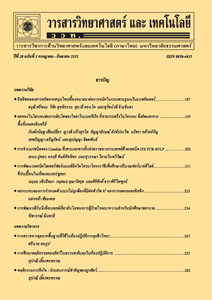ผลร่วมของสารสกัดใบสาบเสือและกระถินเทพาต่อการงอกและการเจริญของไมยราบ
Main Article Content
Abstract
Many plant species can produce secondary metabolite compounds that affect growth of other plants including weeds. They can be developed for weed control. Therefore, the aim of this study is to determine the synergistic effect of Chromolaena odorata and Acacia mangium leaves crude extracts on germination and growth of some weeds in rice field. The crude extracts were extracted with dichloromethane and methanol for C. odorata and A. mangium extraction, respectively. Then, the phytochemical screening of C. odorata and A. mangium ensured the presence of alkaloids, coumarins, flavonoids, terpenoids and steroids and alkaloids, tannins, reducing sugars and steroids. The synergistic effect between C. odorata and A. mangium extracts with ratio of 1 : 1, 2 : 1 and 1 : 2 was determined the germination and growth of sensitive plant (Mimosa pudica L.) and Sangyod rice (Oryza sativa L.) as control. The results showed that the ratio of 2 : 1 was effective to inhibit germination (73.40 %) and growth; root length (38.27 %), shoot length (77.88 %) of the sensitive plant. However, this ratio of the extracts was not effective on Sangyod rice germination and growth. Therefore, C. odorata and A. mangium leaves crude extracts can control specific weed germination and growth.
Article Details
References
[2] Antralina, M., Istina, I.N. and Yuwariah, Y. and Simarmatac, T., 2015, Effect of difference weed control methods to yield of lowland rice in the SOBARI, Proc. Food Sci. 3: 323-329.
[3] Cheng, F. and Cheng, Z., 2015, Research progress on the use of plant allelopathy in agriculture and the physiological and ecological mechanisms of allelopathy, Front Plant Sci. 6: 1202.
[4] Hussain, M.I., González, L. and Reigosa, M.J., 2011, Allelopathic potential of Acacia melanoxylon on the germination and root growth of native species, Weed Biol. Manage. 11: 18-28.
[5] Baratelli, T.d.G., Candido, G.A.C, Wessjo hann, L.A., Kuster, R.M. and Simas, N.K., 2012, Phytochemical and allelopathic studies of Terminalia catappa L. (Combretaceae), Biochem. Syst. Ecol. 41: 119-125.
[6] Yusoff, N. and Ismail, S., 2015, Allelopathic potential of Chromolaena odorata and Mikania micrantha on Brassica chinensis var. parachinensis, AIP Conference Proceedings, 1678: 020024.
[7] Fara, W.A.H, Ahmad M.I, Muhamad Y.H., 2014, Preliminary study on allelopathic effect from Chromolaena odorata (Siam Weed) leaves extract towards Vigna Radiata, Int. J. Eng. Res. Tech. 3: 406-411.
[8] Ngono, N.A., Ebelle, E.R., Ndifor F.B., Amvam Z.P. and Bouchet, P., 2006, Antifungal activity of Chromolaena odorata (L.) King & Robinson (Asteraceae) of Cameroon, Chemotherapy 52: 103-106.
[9] Ngozi, I.M., Ikewuchi, J. and Ikewuchi, C., 2009, Chemical profile of Chromolaena odorata L. (King and Robinson) leaves, Pak. J. Nutr. 8: 521-524.
[10] Hussain, M.I., González, L., Souto, C. and Reigosa, M.J., 2011, Ecophysiological responses of three native herbs to phytotoxic potential of invasive Acacia melanoxylon R, Br. Agroforest Syst. 83: 149.
[11] Ismail, N.A.N., 2014, Allelopathic effects of invasive Acacia mangium on germination and growth of local paddy varieties, J. Agro. 13: 158-168.
[12] Iqbal, E., Salim, K.A. and Lim, L.B.L., 2015, Phytochemical screening, total phenolics and antioxidant activities of bark and leaf extracts of Goniothalamus velutinus (Airy Shaw) from Brunei Darussalam, J. King Saud Univ. Sci. 27: 224-232.
[13] Berendji, S., Asghari, J.B. and Matin, A.A., 2008, Allelopathic potential of rice (Oryza sativa) varieties on seedling growth of barnyardgrass (Echinochloa crus-galli), J. Plant Interac. 3: 175-180.
[14] Cheng, F. and Cheng, Z., 2015, Research progress on the use of plant allelopathy in agriculture and the physiological and ecological mechanisms of allelopathy, Front. Plant Sci. 6: 1020.
[15] Harini, J.J. and Geetha, N., 2014, Phytochemical constituents of different extracts from the leaves of Chromolae naodorata (L.) King and Robinson, Int. J. Pharm. Sci. Bus. Manage. 2: 13-20.
[16] Agaba, T.A., Fawole, A. and Claudius-Cole, O., 2015, Screening of Siam Weed (Chromolaena Odorata) and African Custard Apple (Annona Senegalensis) for nematicidal activity, J. Biol, Agri. Health 5: 50-56.
[17] Oyun, M.B., 2006, Allelopathic potential lities of Gliricidia sepium and Acacia auriculiformis on the germination and seedling vigour of Maize (Zea mays L.), Amer. J. Agri. Biol. Sci. 1: 44-47.
[18] Einhellig, F.Y., 2006, The Physiology of Allelochemical Action: Clues and Views, p. 1942, In Reigosa, M.J. and Pedrol, N. (Eds.), Allelopathy: From Molecules to Ecosystems, Science Publishers, Enfield, New Hampshire.
[19] Rice, E.L., 1984, Mechanisms of Action of Allelopathic Agents, pp. 320-344, Allelo pathy, 2nd Ed., Academic Press, San Diego.


